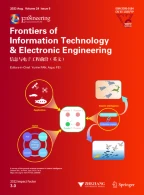Abstract
In underwater applications of contactless power transmission (CLPT) systems, high pressure and noncoaxial operations will change the parameters of electromagnetic (EM) couplers. As a result, the system will divert from its optimum performance. Using a reluctance modeling method, we investigated the gap effects on the EM coupler in deep-sea environment. Calculations and measurements were performed to analyze the influence of high pressure and noncoaxial alignments on the coupler. It was shown that it is useful to set a relatively large gap between cores to reduce the influence of pressure. Experiments were carried out to verify the transferring capacity of the designed coupler and system for a fixed frequency. The results showed that an EM coupler with a large gap can serve a stable and efficient power transmission for the CLPT system. The designed system can transfer more than 400 W electrical power with a 2-mm gap in the EM coupler, and the efficiency was up to 90% coaxially and 87% non-coaxially in 40 MPa salt water. Finally, a mechanical layout of a 400 W EM coupler for the underwater application in 4000-m deep sea was proposed.
Similar content being viewed by others
References
Ayano, H., Nagase, H., Inaba, H., 2004. A highly efficient contactless electrical energy transmission system. Electr. Eng. Jpn., 148(1):66–74. [doi:10.1002/eej.10290]
Choi, B., Nho, J., Cha, H.Y., Ahn, T., Choi, S., 2004. Design and implementation of low-profile contactless battery charger using planar printed circuit board windings as energy transfer device. IEEE Trans. Ind. Electron., 51(1):140–147. [doi:10.1109/TIE.2003.822039]
Covic, G.A., Boys, J.T., Kissin, M.L.G., Lu, H.G., 2007. A three-phase inductive power transfer system for roadway-powered vehicles. IEEE Trans. Ind. Electron., 54(6):3370–3378. [doi:10.1109/TIE.2007.904025]
Feezor, M.D., Sorrell, F.Y., Blankinship, P.R., Bellingham, J.G., 2001. An interface system for autonomous undersea vehicles. IEEE J. Ocean. Eng., 26(4):522–525. [doi:10.1109/48.972087]
Fernandez, C., Garcia, O., Prieto, R., Cobos, J.A., Uceda, J., 2002. Overview of Different Alternatives for the Contactless Transmission of Energy. Proc. 28th Annual Conf. of the IEEE Industrial Electronics Society, 1–4:1318–1323. [doi:10.1109/IECON.2002.1185466]
Green, A.W., Boys, J.T., 1994. 10 kHz Inductively Coupled Power Transfer: Concept and Control. Proc. 5th Int. Conf. on Power Electronics and Variable-Speed Drives, 399:694–699. [doi:10.1049/cp:19941049]
Hayes, J.G., O’Donovan, N., Egan, M.G., O’Donnell, T., 2003. Inductance Characterization of High-Leakage Transformers. 18th Annual IEEE Applied Power Electronics Conf. and Exposition, 1–2:1150–1156. [doi:10.1109/APEC.2003.1179361]
Hirai, J., Kim, T.W., Kawamura, A., 2000. Study on intelligent battery charging using inductive transmission of power and information. IEEE Trans. Power Electron., 15(2): 335–345. [doi:10.1109/63.838106]
Jung, K.H., Kim, Y.H., Kim, J., Kim, Y.J., 2009. Wireless power transmission for implantable devices using inductive component of closed magnetic circuit. Electron. Lett., 45(1):21–22. [doi:10.1049/el:20092241]
Kojiya, T., Sato, F., Matsuki, H., Sato, T., 2004. Automatic Power Supply System to Underwater Vehicles Utilizing Non-contacting Technology. MTS/IEEE Techno-Ocean, 1–4:2341–2345. [doi:10.1109/OCEANS.2004.1406521]
Kojiya, T., Sato, F., Matsuki, H., Sato, T., 2005. Construction of Non-contacting Power Feeding System to Underwater Vehicle Utilizing Electro Magnetic Induction. Europe Oceans, 1–2:709–712. [doi:10.1109/OCEANSE.2005.1511801]
le Floch, M., Loaec, J., Pascard, H., Globus, A., 1981. Effect of pressure on soft magnetic-materials. IEEE Trans. Magn., 17(6):3129–3134. [doi:10.1109/TMAG.1981.1061600]
Liu, X., Hui, S.Y.R., 2008. Optimal design of a hybrid winding structure for planar contactless battery charging platform. IEEE Trans. Power Electron., 23(1):455–463. [doi:10. 1109/TPEL.2007.911844]
Loaec, J., Globus, A., le Floch, M., Johannin, P., 1975. Effect of hydrostatic pressure on magnetization mechanisms in Ni-Zn ferrite. IEEE Trans. Magn., 11(5):1320–1322. [doi:10.1109/TMAG.1975.1058884]
Loaec, J., le Floch, M., Johannin, P., 1978. Effect of hydrostatic-pressure on susceptibility frequency spectrum of polycrystalline Mn-Zn and Ni-Zn ferrites. IEEE Trans. Magn., 14(5):915–917. [doi:10.1109/TMAG.1978.1059 959]
McGinnis, T., Henze, C.P., Conroy, K., 2007. Inductive Power System for Autonomous Underwater Vehicles. OCEANS, 1–5:736–740. [doi:10.1109/OCEANS.2007.4449219]
Papastergiou, K.D., Macpherson, D.E., 2007a. An airborne radar power supply with contactless transfer of energy-Part I: rotating transformer. IEEE Trans. Ind. Electron., 54(5):2874–2884. [doi:10.1109/TIE.2007.902044]
Papastergiou, K.D., Macpherson, D.E., 2007b. An airborne radar power supply with contactless transfer of energy-Part II: converter design. IEEE Trans. Ind. Electron., 54(5):2885–2893. [doi:10.1109/TIE.2007.901370]
Papastergiou, K.D., Macpherson, D.E., 2008. Air-Gap Effects in Inductive Energy Transfer. IEEE Power Electronics Specialists Conf., 1–10:4092–4097. [doi:10.1109/PESC.2008.4592594]
Ryu, M., Cha, H., Park, Y., Baek, J., 2005. Analysis of the Contactless Power Transfer System Using Modelling and Analysis of the Contactless Transformer. 31st Annual Conf. of the IEEE Industrial Electronics Society, 1–3:1036–1042. [doi:10.1109/IECON.2005.1569047]
Si, P., Hu, A.P., Malpas, S., Budgett, D., 2008. A frequency control method for regulating wireless power to implantable devices. IEEE Trans. Biomed. Circ. Syst., 2(1):22–29. [doi:10.1109/TBCAS.2008.918284]
Stielau, O.H., Covic, G.A., 2000. Design of Loosely Coupled Inductive Power Transfer Systems. Proc. Int. Conf. on Power System Technology, p.85–90. [doi:10.1109/ICPST.2000.900036]
Villa, J.L., Sallan, J., Llombart, A., Sanz, J.F., 2009. Design of a high frequency inductively coupled power transfer system for electric vehicle battery charge. Appl. Energy, 86(3):355–363. [doi:10.1016/j.apenergy.2008.05.009]
Wang, C.S., Covic, G.A., Stielau, O.H., 2004. Power transfer capability and bifurcation phenomena of loosely coupled inductive power transfer systems. IEEE Trans. Ind. Electron., 51(1):148–157. [doi:10.1109/TIE.2003.822038]
Wang, J., Witulski, A.F., Vollin, J.L., Phelps, T.K., Cardwell, G.I., 1999. Derivation, Calculation and Measurement of Parameters for a Multi-Winding Transformer Electrical Model. 14th Annual Applied Power Electronics Conf. and Exposition, p. 220–226. [doi:10.1109/APEC.1999.749513]
Yoshioka, D., Sakamoto, H., Ishihara, Y., Matstumoto, T., Timischl, F., 2007. Power feeding and data-transmission system using magnetic coupling for an ocean observation mooring buoy. IEEE Trans. Magn., 43(6):2663–2665. [doi:10.1109/TMAG.2007.893775]
Zhang, N., Wang, Z.L., Fang, X., 2008. Piezoimpedane and pressure sensors with NiZn ferrite device. Sens. Actuat. A, 147(2):504–507. [doi:10.1016/j.sna.2008.06.012]
Author information
Authors and Affiliations
Corresponding author
Additional information
Project supported by the National High-Tech R & D Program (863) of China (No. 2007AA091201), the Natural Science Foundation of Zhejiang Province, China (No. Y5090117), and the Qianjiang Excellence Project of Zhejiang Province, China (No. 2009R10036)
Rights and permissions
About this article
Cite this article
Li, Zs., Li, Dj., Lin, L. et al. Design considerations for electromagnetic couplers in contactless power transmission systems for deep-sea applications. J. Zhejiang Univ. - Sci. C 11, 824–834 (2010). https://doi.org/10.1631/jzus.C0910711
Received:
Accepted:
Published:
Issue Date:
DOI: https://doi.org/10.1631/jzus.C0910711
